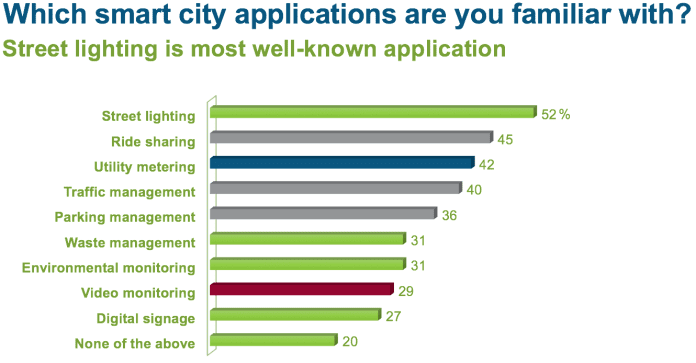Pair of studies focus on where and how smart city tech can make the biggest difference
In many ways the digital transformation from a city to a smart city is the ultimate application of the internet of things–the umbrella term covers a wide array of IoT solutions: connected lighting, environmental sensing, smart transportation and utilities, more connected, accessible city services, massive data collection and analysis, and improved public safety. All with a two-fold goal of providing money- and resource-saving efficiencies to municipal managers, and improved quality-of-life for residents, both initiatives increasingly highlighted by the ongoing mega-trend of urbanization.
Two recently published studies touch on complementary aspects of the smart city movement. InterDigital’s smart city-focused subsidiary Chordant, in conjunction with CA Technologies, has created an index enumerating the “relative potential benefits of smart city technology in America’s major metropolitan areas.” And Silver Spring Networks, in cooperation with the U.S. Department of Energy and “energy literacy” group Power Over Energy, examined myriad factors focused on mind-share afforded smart city technology, as well as leading applications that serve as the building blocks of smart cities. Let’s take these one at a time.
Chordant and CA Technologies developed the “Smart Cities Benefit Index” ranking 50 cities in the United States to “examine the relative potential benefits” of smart city adoption, which Compass Intelligence, another contributor to the index, projects to have a market value in excess of $1.4 trillion by 2020. Compass Founder and Principal Consultant Stephanie Atkinson said the goal is to examine “each city’s expected position and readiness to embrace, adopt, implement, and scale smart city projects, initiatives, investments, technologies, and solutions. Those cities ranked higher or that have higher total points on the index are expected to be earlier adopters of smart city technologies and could potentially reap greater benefits of a return on investment.”
Per the index, the top 10 cities are Boston, Chicago, Atlanta, Philadelphia, Austin, San Diego, Seattle, New York, Phoenix and Kansas City. The index authors note that while familiar tech hubs like Boston and Austin are among the leaders, “more traditionally industrial cities including Chicago, Atlanta and Philadelphia…follow close behind.”
Now, the Silver Spring Networks research–this piece is significantly more broad than what’s examined above, and serves largely to gauge public awareness of what a smart city is, most widely recognized applications and perceived benefits, among other topics. The results were derived from a sample set of 500 Americans between the ages of 18 and 65 living in areas with populations ranging from less than 1,000 to more than 1 million.
Key takeaways include:
- 80% “had little to no knowledge” about the topic;
- Armed with a little education on the subject, 75% “indicated smart city technology would have a positive impact on their lives;”
- Preeminent benefits were identified as “reducing pollution and increasing public safety,” and major drawbacks were seen as “cost and privacy.”
In terms of mind-share, the top five applications were geared toward street lighting, ride sharing, utility metering, traffic management and parking management. That first one, street lighting, is important for two reasons. It’s a major thrust of Silver Spring Networks’ smart city solutions, and connected lighting sites can serve as a platform for lots of other smart city-type projects. In a nutshell, a street light is already connected to power infrastructure and is likely located along pedestrian and vehicular corridors. Add in cellular connectivity and the street light can be leveraged for traffic and environmental sensors, cameras and gunshot detection devices, and, back to the cellular piece, as a place to densify the existing macro network with a small cell. Learn more about the role of smart lighting in smart cities here.

